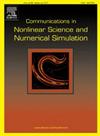求解图神经扩散网络的电荷保留方法
IF 3.4
2区 数学
Q1 MATHEMATICS, APPLIED
Communications in Nonlinear Science and Numerical Simulation
Pub Date : 2024-10-10
DOI:10.1016/j.cnsns.2024.108392
引用次数: 0
摘要
本文旨在对图形神经网络(GNN)模型所基于的扩散问题进行系统的数学解释。我们研究方法的出发点是一个耗散函数,它导致了动力学方程,使我们能够研究模型的对称性。我们简要回顾了图论及其与网络 σ 模型之间的关系,并根据我们的分析进行了调整。我们讨论了守恒电荷,并提供了求解动力学方程的电荷守恒数值方法。在任何动态系统和 GRAph 神经扩散(GRAND)中,了解电荷值及其沿进化流的守恒性,可以为理解 GNN 和其他网络如何利用其学习能力工作提供一种方法。本文章由计算机程序翻译,如有差异,请以英文原文为准。
A charge-preserving method for solving graph neural diffusion networks
The aim of this paper is to give a systematic mathematical interpretation of the diffusion problem on which Graph Neural Networks (GNNs) models are based. The starting point of our approach is a dissipative functional leading to dynamical equations which allows us to study the symmetries of the model. We provide a short review of graph theory and its relation with network -models adapted to our analysis. We discuss the conserved charges and provide a charge-preserving numerical method for solving the dynamical equations. In any dynamical system and also in GRAph Neural Diffusion (GRAND), knowing the charge values and their conservation along the evolution flow could provide a way to understand how GNNs and other networks work with their learning capabilities.
求助全文
通过发布文献求助,成功后即可免费获取论文全文。
去求助
来源期刊

Communications in Nonlinear Science and Numerical Simulation
MATHEMATICS, APPLIED-MATHEMATICS, INTERDISCIPLINARY APPLICATIONS
CiteScore
6.80
自引率
7.70%
发文量
378
审稿时长
78 days
期刊介绍:
The journal publishes original research findings on experimental observation, mathematical modeling, theoretical analysis and numerical simulation, for more accurate description, better prediction or novel application, of nonlinear phenomena in science and engineering. It offers a venue for researchers to make rapid exchange of ideas and techniques in nonlinear science and complexity.
The submission of manuscripts with cross-disciplinary approaches in nonlinear science and complexity is particularly encouraged.
Topics of interest:
Nonlinear differential or delay equations, Lie group analysis and asymptotic methods, Discontinuous systems, Fractals, Fractional calculus and dynamics, Nonlinear effects in quantum mechanics, Nonlinear stochastic processes, Experimental nonlinear science, Time-series and signal analysis, Computational methods and simulations in nonlinear science and engineering, Control of dynamical systems, Synchronization, Lyapunov analysis, High-dimensional chaos and turbulence, Chaos in Hamiltonian systems, Integrable systems and solitons, Collective behavior in many-body systems, Biological physics and networks, Nonlinear mechanical systems, Complex systems and complexity.
No length limitation for contributions is set, but only concisely written manuscripts are published. Brief papers are published on the basis of Rapid Communications. Discussions of previously published papers are welcome.
 求助内容:
求助内容: 应助结果提醒方式:
应助结果提醒方式:


